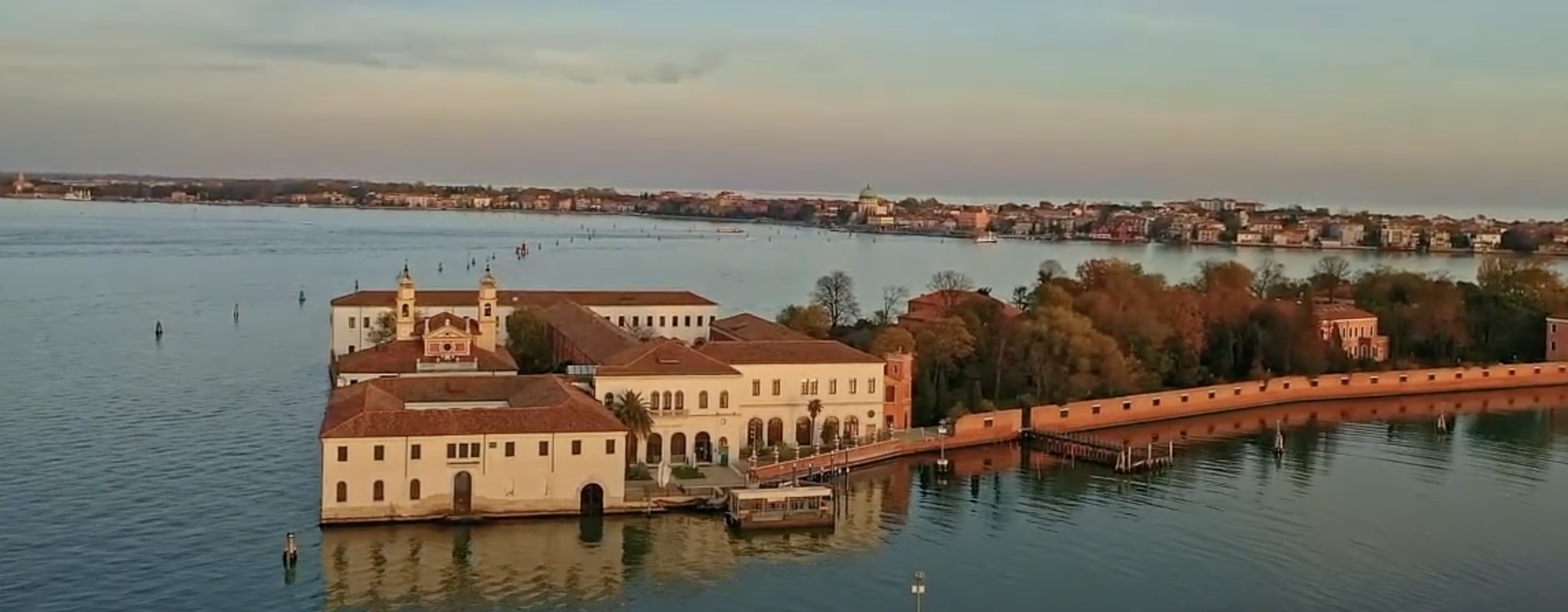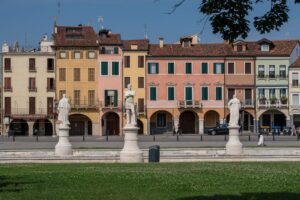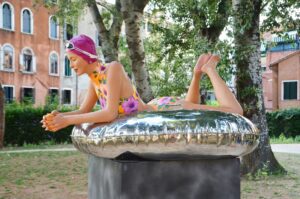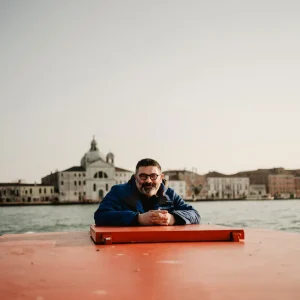San Servolo Island — Venice’s Forgotten Asylum and Its Astonishing Rebirth
Venice has more islands than bridges, and each one tells a different story. Murano glows with glass furnaces. Burano bursts with color. Torcello whispers of origins. But between San Marco and the Lido lies San Servolo — an island whose past reads like a novel: monks, soldiers, psychiatric patients, and now artists and students.
For centuries, this island mirrored Venice’s most complex emotions — its fears, its compassion, its need to isolate and to heal. Today, San Servolo stands transformed: a campus, a conference hub, a place of reflection and renewal. Walking through its gardens feels like crossing layers of history, from prayer to medicine to modern art — one of the lagoon’s most fascinating hidden gems.
📍 1. Where Is San Servolo?
San Servolo lies in the southern Venetian lagoon, between San Marco and the Lido. It’s just a ten-minute vaporetto ride from Riva degli Schiavoni — yet it feels worlds away from the crowded squares of Venice.
From the island’s waterfront, the panorama is breathtaking: the domes of St. Mark’s Basilica to the west, the open Adriatic to the east. But once you step inside, the mood changes — quiet paths, old brick facades, courtyards shaded by cypress and palm. San Servolo feels like a secret kept in plain sight.
🙏 2. The Monastic Origins — An Island of Faith
The story of San Servolo begins in the 8th century, when Benedictine monks sought solitude here. They cultivated the land, prayed in wooden chapels, and turned the marshy island into a self-sufficient microcosm of devotion.
By the 12th century, the monastery passed to the Augustinian nuns, who built cloisters and gardens. For hundreds of years, San Servolo was a spiritual retreat — a quiet sister to nearby San Giorgio Maggiore and San Lazzaro degli Armeni.
But the tides of history rarely leave Venice untouched. What began as a house of prayer would soon become a house of healing — and of confinement.
⚕️ 3. From Monks to Medicine — The Soldiers’ Hospital
By the 15th century, Venice was an empire on the water — and its navy brought new needs. The Republic converted San Servolo’s monastery into a hospital for soldiers and sailors. Its isolation made it ideal for treating contagious diseases and injuries sustained at sea.
Here, physicians of the Venetian Republic experimented with early medical care — herbal remedies, isolation wards, and the belief that fresh air and prayer could restore both body and soul. The transformation from monastery to hospital would pave the way for San Servolo’s most famous — and controversial — role.
🧠 4. The Asylum of Venice — Centuries of Silence
In 1725, the Venetian Senate issued a decree that changed the island forever: San Servolo was to become the city’s official hospital for the mentally ill. For the next 250 years, it would be known as “the asylum of Venice.”
At its height, San Servolo housed more than 1,000 patients. Doctors, priests, and nuns lived alongside them, creating an isolated community governed by discipline, medicine, and faith.
The practices of the time — though well-intentioned — often seem cruel by today’s standards:
- Patients were kept in isolation wards.
- Treatments included early experiments with electrotherapy and sedatives.
- Behavior was strictly controlled under moral and religious supervision.
Yet, this was also where psychiatry in Venice began to take shape. San Servolo became both a place of suffering and a laboratory for progress — a microcosm of the Enlightenment’s complicated relationship with the mind.
⚔️ 5. Napoleonic and Austrian Eras — Discipline and Expansion
When Napoleon’s troops entered Venice in 1797, the island once again changed hands. The French reorganized its administration; under Austrian rule, San Servolo expanded dramatically. New wings, laboratories, and even gardens were added — all designed for “order and treatment.”
By the mid-19th century, San Servolo had become one of Europe’s largest psychiatric institutions. Medical journals reported on its structure; doctors exchanged letters with colleagues in Vienna and Paris. Venetian families, fearful yet hopeful, sent relatives here seeking cure — or control.
For better or worse, San Servolo had become a city within the city — a society built on the margins of reason.
💊 6. The 20th Century — Reform, Resistance, and Closure
In the early 1900s, the hospital continued to evolve. Treatments grew more scientific; wards were segregated by gender, condition, and class. After World War II, modern psychiatry brought both hope and new ethical dilemmas.
Everything changed in 1978 with Italy’s Basaglia Law, named after psychiatrist Franco Basaglia, which abolished asylums nationwide. It declared that mental health care must return to the community, not remain behind locked gates. San Servolo’s asylum closed soon after, ending more than two centuries of confinement.
What remained was a haunting legacy: thousands of patient files, handwritten notes, and rooms filled with the traces of human suffering — but also resilience.
🌅 7. The Rebirth — From Asylum to Academy
Where others saw ruins, Venice saw potential. In the 1990s, the city and the province of Venice launched an ambitious project to restore San Servolo as a cultural and educational center.
Today, the island has become a symbol of transformation:
- Venice International University (VIU): a consortium of universities from around the world, where students study in English against a backdrop of lagoon and light.
- Conference and event venues: from academic symposia to art openings and even elegant weddings.
- Biennale exhibitions: San Servolo often serves as a venue for installations that explore themes of memory, identity, and renewal.
San Servolo has gone from a place of exclusion to one of exchange — a living metaphor for Venice’s own capacity for reinvention.
🧬 8. The Museum of Madness — Memory Made Visible
No visit to San Servolo is complete without stepping inside its most moving space: the Museo del Manicomio — literally, the Museum of the Asylum.
This museum doesn’t sensationalize; it educates. Its exhibits bring to light what once was hidden:
- Original medical instruments and early psychiatric devices.
- Registers and photographs of patients, spanning three centuries.
- Pharmaceutical jars, surgical kits, and handwritten diagnoses.
- Personal belongings — rosaries, letters, drawings — that humanize the statistics.
The museum invites reflection rather than fear. It’s not about ghosts — it’s about people. Through preserved artifacts and testimonies, it honors the dignity of those who once lived here.
🌿 9. San Servolo Today — A Living Island of Learning
Today’s San Servolo balances serenity with vitality. Its monumental architecture has found new purpose: lecture halls instead of wards, dormitories instead of cells, and gardens alive with conversation and art.
Visitors encounter:
- Peaceful courtyards framed by porticoes and marble corridors.
- Public sculptures and contemporary installations that reinterpret the island’s past.
- Students from across Europe, America, and Asia walking the same paths once crossed by monks and doctors.
In spring, the scent of jasmine fills the air. In autumn, Biennale artists hang canvases where therapy sessions once took place. The transformation feels almost symbolic — proof that places, like people, can heal.
🎭 10. A Cultural Stage — Art, Conferences, and Global Dialogue
San Servolo has quietly become one of Venice’s most dynamic cultural venues. The island hosts events ranging from contemporary art shows to environmental summits. During the Venice Biennale, its halls fill with installations and performances that echo its themes of mind, memory, and freedom.
Music, cinema, and theater festivals bring new audiences. Academic conferences discuss climate change, digital ethics, and mental health. Every gathering here seems to carry a touch of poetic justice — ideas flourishing where confinement once reigned.
In this way, San Servolo bridges Venice’s intellectual and emotional worlds — much like San Giorgio Maggiore does for art and spirituality, or Certosa does for nature and sustainability.
🚤 11. Visiting San Servolo — A Quiet Escape from Venice
Getting there: Take Vaporetto Line 20 from San Zaccaria (near St. Mark’s Square). The same route stops at San Giorgio and San Lazzaro degli Armeni.
What to see:
- Museum of Madness: open afternoons; guided visits available.
- Gardens and courtyards: free to explore, perfect for photography and contemplation.
- Exhibitions: check schedules during Biennale seasons for contemporary art and design events.
Best time to visit: Morning for calm light and open space; late afternoon for a golden-hour walk among sculptures and sea breezes.
Unlike Murano or Burano, San Servolo has no souvenir shops, only stories — and those are far more valuable.
💡 12. Why San Servolo Matters — Venice’s Memory Made Modern
San Servolo is Venice in miniature: faith, medicine, tragedy, and rebirth coexisting on one small island. It reflects how the city treats its shadows — not by hiding them, but by turning them into light.
- It shows Venice’s capacity for reinvention.
- It keeps alive the memory of those once forgotten.
- It connects the past with the curiosity of future generations.
For travelers seeking authenticity, San Servolo offers a different kind of beauty — introspective, educational, and deeply human. It’s one of those places that stays with you long after you’ve left the lagoon.
🌺 13. Conclusion — From Silence to Dialogue
San Servolo is not just another island in the lagoon — it’s a mirror of Venice itself. A monastery turned asylum turned university, it carries within its walls the city’s endless cycle of decay and renewal.
To walk through its courtyards is to feel the echo of centuries — monks praying, doctors observing, students debating. The silence here isn’t empty; it’s full of stories.
👉 Explore San Servolo and Venice’s hidden islands with Tour Leader Venice — a private journey through the lagoon’s most revealing places: San Giorgio, San Lazzaro degli Armeni, Certosa, and beyond.
Because the true Venice isn’t only in its canals — it’s in its islands, where history dares to reinvent itself.







